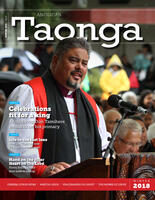When the January floods struck South East Queensland Bishop Tom Brown of Wellington made contact with Archbishop Phillip Aspinall, his counterpart in Brisbane.
Wellington and Brisbane are companion dioceses, and Bishop Tom wanted to offer practical help.
As a result, Jean Malcolm from St James Lower Hutt and Winton Davies from Kapiti flew to Brisbane in late January to stand beside the clergy and people of the Cunningham Archdeaconary.
Winton Davies is a former police chaplain and an experienced trauma counsellor. Here are some excerpts from his report about what he found.
MIDDLE PARK
On Sunday 21 January I was taken by the Warden of the parish of North Ipswich to the Middle Park parish where Tania Eicher was the priest in charge. Tania invited me to share in and speak during the service.
After the service 50-60 parishioners sat down with me to unpack the trauma they had endured. The extreme flooding had engendered all sorts of feelings and insecurity. There was a great outpouring of loss, support and mutual concern.
For example: One young man was radically affected by the water reaching the ceiling of his new home. The house he had worked hard and saved for, was a total wreck. The tricky uncertain situation of insurance from this type of flood meant that he, and so many others, were not covered by insurance of their homes and contents.
We entered a time of prayer after the session and the young man and his father stayed behind for further conversation, prayer and ministry.
FERNVALE
With Dan Berris, who is the assistant curate at St Paul's Ipswich, Jean and I visited a state school at Fernvale where a huge distribution centre had been set up. Here people flooded out could pick up food, clothes and toiletries etc.
The parish of St Paul's had taken up a special offering to be used by the school to buy school accessories. On return we visited Karalee and parishioners whose homes had water up to the roof.
The contents of the homes were all outside drying out in the sun. One of these homes belonged to the director of music at St Paul's. It was sad to see her piano totally ruined and to learn that much of her sheet music had been destroyed.
KARALEE
Kevin Ellem a retired priest who had attended our Saturday meeting with clergy of the archdeaconary asked me to share a room at a local chemist shop. This room had been set up to allow locals to drop in and have a chat. A few people took advantage of that; eg. one mother with her one year old who had been flooded out.
Kevin had a close shave himself. The Brisbane River had risen 16 metres and destroyed 300 grape vines on the lower part of the property he and his wife Jenny own. They had to evacuate – and the river rose to their doorstep.
QUEENSLAND POLICE
The Queensland Police played a big part in the recovery of bodies drowned in the Lockyer Valley.
They were also stretched in staffing road blocks and communicating with locals who were traumatised by what had happened to them and their communities. Extra Federal police were brought in to assist the local force.
I met the Senior Police Chaplain Rod Wood who invited me to attend the funeral service of a young boy, Jesse Wickman (four years old). Jesse was being rescued together with his parents and brother. When the father went to hand Jesse over to a rescurer he slipped from the man’s grasp and disappeared in the torrent of water. Jesse’s mother’s eulogy was most moving as she used the form of a prayer for God to look after her little boy. This was not an isolated incident.
GATTON AND GRANTHAM IN THE LOCKYER VALLEY
In the Lockyer Valley small streams became raging rivers. The water came like a tsunami upon Grantham taking everything and everybody with it. Twenty two people drowned. Houses with people in them were flushed across the land.
Jen Colbrahams, the priest in charge of the Gatton parish had been in the thick of things. She needed a break, so she asked Jean and myself to assist and relieve her.
For three days we visited the emergency centre (two large marquees set up on higher ground) and interacted with the locals and a host of emergency workers.
I sat down beside many a local who related their terrifying experiences, eg. Ken, who was trapped in his house with his daughter and two dogs. After breaking a window they managed to get through the water and scramble to the roof where a helicopter rescued them.
Ray, a young man and father of three, lost everything. He had collected 76 motor bikes to start a business. He hasn't yet found the motor bikes.
Paul, who sold locally grown produce from a stall, had everything washed away.
The locals came to the Recovery Centre marquees for refreshments and information. At 12 noon every day there was a hugh gathering of victims of the floods and carers who were addressed by local councillors, police and emergency workers. Asbestos was a major problem here and throughout south east Queensland.
Only appointed personnel could deal with the hazard of asbestos in buildings.
On Sunday 30 January we held a service in the local Grantham church of St. Grabriel's.
Jean had prepared a moving relevant service for the locals. This was much appreciated and extra copies left in the church for others to use.
VISIT TO THE BREMER WATERS RETIREMENT ESTATE
I visited the above estate at the request of an Ipswich City Councillor whom Jean and I met after our arrival in Ipswich. The councillor was a nephew of an elderly couple who lived in this estate.
The home and contents had been ruined by the recent floods.
The couple and a neighbour who was helping told how the Bremer River below the estate had risen dramatically and entered their four year old home.
As the story unfolded I learned that the couple, along with residents from 122 other villas, had to evacute their homes at short notice.
The couple are not covered by insurance by this type of flooding. The contents are also not covered. The majority of residents severely affected by the damage have no recourse or claim upon their insurance companies.
The life savings of the couple were around $25,000. This money is now needed to repair the damage to their home.
The residents are unable to return to their villas. Until the damage is repaired they are staying with relatives, who are also putting up their neighbours.
These people are angry. The owners of the estate have shown no mercy or compassion.
When these desperate homeowners have called in workmen to do repairs, the workmen have been turned away. Only workmen designated by the estate owners are allowed in.
The residents pay $256 a fortnight for use of amenities in their village. There are now no amenities – and yet the owners still have to pay. I believe an injustice has been inflicted upon these people.
They are traumatised, frustrated, distressed and hurt by the actions of others, and by the events that have overcome them. I gave them a listening ear and a little consolation.
REFLECTIONS
There were many expressions of gratitude that we had come over to be present and stand by those who had turned their lives upside down, and the diocesan companionship between Wellington and Brisbane is alive and well.
“My grace is sufficient for you.”
These were the words that often came to me, and that I often passed on.
Winton Davies.

















Comments
Log in or create a user account to comment.